The Delicate Balance of Nature and Romance in Rococo Art
 Nov, 17 2025
Nov, 17 2025
Imagine a world where every curve feels like a sigh, where flowers spill from gilded frames, and lovers hide behind silk curtains in gardens that don’t quite exist. That’s Rococo art - not grand, not serious, but utterly alive with tenderness and playfulness. It emerged in early 18th-century France as a reaction against the heavy, solemn grandeur of Baroque. Where Louis XIV’s Versailles shouted power, Rococo whispered desire. And at its heart? A quiet, obsessive love affair between nature and romance.
What Makes Rococo Different?
Rococo isn’t just decorative. It’s emotional. Artists like François Boucher, Jean-Honoré Fragonard, and Antoine Watteau didn’t paint myths to teach morals. They painted them to make you feel something - longing, mischief, quiet joy. Their canvases overflow with pastel pinks, soft blues, and creamy whites. Everything looks touched by morning light. Trees bend like they’re leaning in to listen. Clouds aren’t just sky - they’re cotton candy drifting above porcelain-skinned women in silk gowns.
The style rejected symmetry. Instead, it embraced asymmetry, curves, and chaos that somehow felt perfect. Walls weren’t flat - they were carved with shells, vines, and scrolling leaves. Furniture looked like it had grown out of the floor. Even the paint strokes seemed to dance. This wasn’t art meant for kings to impress diplomats. It was made for private salons, boudoirs, and country retreats - places where intimacy mattered more than spectacle.
Nature as a Lover, Not a Backdrop
In Renaissance art, nature was a stage. In Baroque, it was a symbol of divine order. But in Rococo, nature became a participant - a quiet partner in romance.
Look at Fragonard’s The Swing. A young woman kicks off her slipper mid-swing, her dress flying open as a hidden lover watches from the bushes. The garden isn’t just setting - it’s complicit. The trees arch like arms embracing the moment. Roses cling to the fence like blush on a cheek. Even the clouds above seem to hold their breath. Nature isn’t passive here. It’s seductive. It hides, it reveals, it leans in.
Watteau’s Pilgrimage to Cythera shows couples floating toward an island of love, guided by Cupid. But notice the trees - their branches twist like lovers entwined. The ground isn’t dirt. It’s covered in moss and wildflowers, soft enough to sink into. The landscape doesn’t frame the scene - it cradles it. Rococo artists didn’t paint nature as something to conquer or admire. They painted it as something to kiss.

Romance Without Grandeur
Rococo romance isn’t about epic declarations. It’s about stolen glances, folded letters, and the brush of a hand passing a teacup. There are no thunderstorms or battlefields. No gods descending from clouds. Instead, you get women in lace reading love poems by candlelight. Men offering flowers with awkward smiles. Children chasing butterflies while their parents smile from the sidelines.
Boucher’s paintings of shepherdesses aren’t idealized peasants. They’re aristocrats playing dress-up in the countryside - but you believe them. Their cheeks are flushed, their eyes are soft, their gestures are real. You can almost hear the rustle of their skirts. Their romance isn’t tragic or doomed. It’s tender, fleeting, and entirely human. That’s what made Rococo revolutionary: it treated love not as a myth, but as a moment.
Even the most extravagant scenes - like a woman being lifted by putti in a pastel sky - feel intimate. The cherubs aren’t angels. They’re mischievous kids who’ve been let loose in a garden. The sky isn’t heaven. It’s a dream you don’t want to wake up from.
The Role of Color and Texture
Rococo didn’t just see nature differently - it felt it. Artists used color like scent. Pale pinks mimicked peach blossoms. Mint greens echoed new leaves. Gold wasn’t just shiny - it was dappled sunlight filtering through leaves. The texture of paint itself was manipulated to mimic silk, fur, petals, and skin.
Look closely at a Boucher portrait. The woman’s dress isn’t just painted - it’s layered. Thin glazes of white over pale blue give the fabric a luminous, weightless quality. Her skin isn’t just light brown - it’s brushed with a hint of rose, as if warmed by the sun. The background isn’t empty. It’s filled with faint, blurred foliage - not detailed enough to be real, but just enough to suggest a garden just beyond the frame.
This was the height of technical skill disguised as effortlessness. Every brushstroke was calculated to feel spontaneous. Every curve was designed to invite touch. You don’t just look at Rococo art - you want to reach out and feel it.

Why It Faded - And Why It Still Matters
Rococo didn’t survive the French Revolution. Its frivolity became a liability. When people were starving, painted nymphs in silk gowns looked like mockery. The Enlightenment pushed for reason over emotion, structure over whimsy. Neoclassicism took over - clean lines, marble, stoic heroes. Rococo was dismissed as shallow, decorative, even decadent.
But time has been kinder. Today, we understand that emotion isn’t weakness. That intimacy isn’t trivial. That a single petal, painted with care, can hold more truth than a thousand speeches about virtue.
Rococo reminds us that beauty doesn’t need to be loud. That love doesn’t need to be dramatic. That nature isn’t just something to preserve - it’s something to feel. In a world obsessed with speed, clarity, and control, Rococo offers something rare: permission to linger. To notice the way light catches a dewdrop. To let a moment breathe.
Visit any garden in spring - the way petals curl open, the way vines twist around trellises, the way shadows move slowly across grass - and you’re seeing Rococo alive. It’s not in museums anymore. It’s in the quiet corners of everyday life.
Where to See Rococo Today
Paris still holds the best collections. The Louvre’s French decorative arts wing is full of Rococo mirrors, clocks, and paintings that glow like candlelight. The Wallace Collection in London has Fragonard’s The Swing and Boucher’s tender portraits. In Vienna, the Belvedere Palace holds a stunning array of pastel-toned scenes that feel like whispered secrets.
But you don’t need a museum. Look at the curled ironwork on a balcony in Melbourne’s Carlton. The way ivy climbs a brick wall. The softness of a morning mist over a park. That’s Rococo - not as a style, but as a feeling. It’s still here. Waiting for you to notice.
What defines the Rococo art style?
Rococo art is defined by its lightness, pastel colors, ornate curves, and playful themes. It emphasizes intimacy, romance, and nature, often depicting aristocrats in garden settings with soft lighting and delicate details. Unlike the drama of Baroque, Rococo feels effortless, whimsical, and emotionally tender.
How is nature portrayed in Rococo paintings?
Nature in Rococo isn’t a background - it’s a character. Trees bend like lovers, flowers spill into scenes, and gardens feel alive with hidden meaning. Artists used foliage to frame moments of tenderness, making nature a silent witness or even a participant in romantic encounters. It’s not idealized landscape - it’s emotional landscape.
Who are the most important Rococo artists?
François Boucher, Jean-Honoré Fragonard, and Antoine Watteau are the three giants of Rococo. Boucher painted sensual, soft portraits of aristocrats in nature. Fragonard captured fleeting, playful moments like The Swing. Watteau introduced the fête galante - scenes of elegant leisure in outdoor settings that became the signature of the style.
Why did Rococo fall out of favor?
Rococo declined after the French Revolution because its association with aristocratic indulgence clashed with rising ideals of equality and reason. Critics called it frivolous and decadent. Neoclassicism replaced it, favoring order, heroism, and classical forms. But its emotional depth has since been rediscovered as a powerful expression of human tenderness.
Is Rococo still relevant today?
Absolutely. Modern design, fashion, and even interior decorating often borrow Rococo’s softness, asymmetry, and love of natural forms. Its emphasis on intimacy, texture, and quiet beauty speaks to today’s desire for calm and authenticity. You see it in floral wallpapers, curved furniture, and the way we frame moments of everyday romance - not as grand events, but as gentle, fleeting experiences.
Next time you walk through a park in autumn, notice how the leaves cling to branches before falling. That hesitation - that quiet pause before letting go - is pure Rococo. It doesn’t need a frame. It doesn’t need a title. It just needs you to stop, look, and feel.